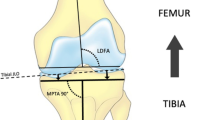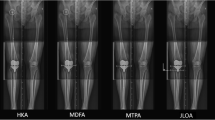Abstract
Purpose
Knee adduction moment (KAM) has been recognized as a good clinical surrogate for medial tibiofemoral joint loading and is associated with implant durability after total knee arthroplasty (TKA). This study aimed to examine the effects of joint line obliquity in kinematically aligned TKA (KA-TKA) on KAM during gait.
Methods
The study enrolled 21 knees from 18 patients who underwent cylindrical axis reference KA-TKA and a matched group of 21 knees from 18 patients who underwent mechanically aligned (MA)-TKA as controls. Gait analyses were performed the day before TKA and at an overall mean of 2.6 years postoperatively. First peak KAM and variables associated with frontal knee kinetics were determined and compared between groups.
Results
In KA-TKA, the proximal tibia was resected with 3.4° ± 1.5° of varus in relation to the mechanical axis, and the final femorotibial shaft axis was 176.7° ± 3.8° with KA-TKA and 174.4° ± 3.0° with MA-TKA. KAM was significantly smaller with KA-TKA than with MA-TKA (p < 0.032). Regarding variables affecting KAM, significant differences were evident between the two TKAs for knee adduction angle (p = 0.0021), lever arm (p = 0.028), and Δlever arm (p = 0.0001).
Conclusions
In KA-TKA, joint line obliquity reduced peak KAM during gait, despite slight varus limb alignment, and this reduced KAM in KA-TKA can tolerate constitutional varus alignment. In clinical settings, KA-TKA thus represents a promising technical option for patients with large coronal bowing of the shaft carrying a risk of increased KAM after TKA.
Level of evidence
III.


Similar content being viewed by others
References
Alnahdi AH, Zeni JA, Snyder-Mackler L (2011) Gait after unilateral total knee arthroplasty: frontal plane analysis. J Orthop Res 29:647–652
Brisson NM, Wiebenga EG, Stratford PW, Beattie KA, Totterman S, Tamez-Peña JG, Callaghan JP, Adachi JD, Maly MR (2017) Baseline knee adduction moment interacts with body mass index to predict loss of medial tibial cartilage volume over 2.5 years in knee osteoarthritis. J Orthop Res. https://doi.org/10.1002/jor.23564
Chang AH, Moisio KC, Chmiel JS, Eckstein F, Guermazi A, Prasad PV, Zhang Y, Almagor O, Belisle L, Hayes K, Sharma L (2015) External knee adduction and flexion moments during gait and medial tibiofemoral disease progression in knee osteoarthritis. Osteoarthr Cartil 23:1099–1106
Courtney PM, Lee GC (2017) Early outcomes of kinematic alignment in primary total knee arthroplasty: a meta-analysis of the literature. J Arthroplast 32:2028–2032
Eckhoff DG, Bach JM, Spitzer VM, Reinig KD, Bagur MM, Baldini TH, Flannery NM (2005) Three-dimensional mechanics, kinematics, and morphology of the knee viewed in virtual reality. J Bone Joint Surg Am 87(Suppl 2):71–80
Eckhoff DG, Hogan C, DiMatteo L, Robinson M, Bach J (2007) Difference between the epicondylar and cylindrical axis of the knee. Clin Orthop Relat Res 461:238–244
Hatfield GL, Hubley-Kozey CL, Astephen Wilson JL, Dunbar MJ (2011) The effect of total knee arthroplasty on knee joint kinematics and kinetics during gait. J Arthroplast 26:309–317
Howell SM, Howell SJ, Kuznik KT, Cohen J, Hull ML (2013) Does a kinematically aligned total knee arthroplasty restore function without failure regardless of alignment category? Clin Orthop Relat Res 471:1000–1007
Hunt MA, Birmingham TB, Bryant D, Jones I, Giffin JR, Jenkyn TR, Vandervoort AA (2008) Lateral trunk lean explains variation in dynamic knee joint load in patients with medial compartment knee osteoarthritis. Osteoarthr Cartil 16:591–599
Hunt MA, Birmingham TB, Giffin JR, Jenkyn TR (2006) Associations among knee adduction moment, frontal plane ground reaction force, and lever arm during walking in patients with knee osteoarthritis. J Biomech 39:2213–2220
Ishikawa M, Kuriyama S, Ito H, Furu M, Nakamura S, Matsuda S (2015) Kinematic alignment produces near-normal knee motion but increases contact stress after total knee arthroplasty: a case study on a single implant design. Knee 22:206–212
Khan SS, Khan SJ, Usman J (2017) Effects of toe-out and toe-in gait with varying walking speeds on knee joint mechanics and lower limb energetics. Gait Posture 53:185–192
Komnik I, Weiss S, Fantini Pagani CH, Potthast W (2015) Motion analysis of patients after knee arthroplasty during activities of daily living—a systematic review. Gait Posture 41:370–377
Lee YS, Howell SM, Won YY, Lee OS, Lee SH, Vahedi H, Teo SH (2017) Kinematic alignment is a possible alternative to mechanical alignment in total knee arthroplasty. Knee Surg Sports Traumatol Arthrosc. https://doi.org/10.1007/s00167-017-4558-y
Liau JJ, Cheng CK, Huang CH, Lee YM, Chueh SC, Lo WH (1999) The influence of contact alignment of the tibiofemoral joint of the prostheses in in vitro biomechanical testing. Clin Biomech 14:717–721
Mahmoudian A, van Dieen JH, Bruijn SM, Baert IA, Faber GS, Luyten FP, Verschueren SM (2016) Varus thrust in women with early medial knee osteoarthritis and its relation with the external knee adduction moment. Clin Biomech 39:109–114
Mandeville D, Osternig LR, Lantz BA, Mohler CG, Chou LS (2008) The effect of total knee replacement on the knee varus angle and moment during walking and stair ascent. Clin Biomech 23:1053–1058
Nagura T, Dyrby CO, Alexander EJ, Andriacchi TP (2002) Mechanical loads at the knee joint during deep flexion. J Orthop Res 20:881–886
Nagura T, Niki Y, Harato K, Mochizuki T, Kiriyama Y (2017) Analysis of the factors that correlate with increased knee adduction moment during gait in the early postoperative period following total knee arthroplasty. Knee 24:250–257
Nakamura S, Tian Y, Tanaka Y, Kuriyama S, Ito H, Furu M, Matsuda S (2017) The effects of kinematically aligned total knee arthroplasty on stress at the medial tibia: a case study for varus knee. Bone Joint Res 6:43–51
Niki Y, Nagai K, Sassa T, Harato K, Suda Y (2016) Comparison between cylindrical axis-reference and articular surface-reference femoral bone-cut for total knee arthroplasty. Knee Surg Sports Traumatol Arthrosc. https://doi.org/10.1007/s00167-016-4251-6
Orishimo KF, Kremenic IJ, Deshmukh AJ, Nicholas SJ, Rodriguez JA (2012) Does total knee arthroplasty change frontal plane knee biomechanics during gait? Clin Orthop Relat Res 470:1171–1176
Ritter MA, Davis KE, Meding JB, Pierson JL, Berend ME, Malinzak RA (2011) The effect of alignment and BMI on failure of total knee replacement. J Bone Joint Surg Am 93:1588–1596
Sharma L, Hurwitz DE, Thonar EJ, Sum JA, Lenz ME, Dunlop DD, Schnitzer TJ, Kirwan-Mellis G, Andriacchi TP (1998) Knee adduction moment, serum hyaluronan level, and disease severity in medial tibiofemoral osteoarthritis. Arthritis Rheum 41:1233–1240
Shull PB, Shultz R, Silder A, Dragoo JL, Besier TF, Cutkosky MR, Delp SL (2013) Toe-in gait reduces the first peak knee adduction moment in patients with medial compartment knee osteoarthritis. J Biomech 46:122–128
Srivastava A, Lee GY, Steklov N, Colwell CW Jr, Ezzet KA, D’Lima DD (2012) Effect of tibial component varus on wear in total knee arthroplasty. Knee 19:560–563
Thorp LE, Sumner DR, Wimmer MA, Block JA (2007) Relationship between pain and medial knee joint loading in mild radiographic knee osteoarthritis. Arthritis Rheum 57:1254–1260
Tsukeoka T, Lee TH, Tsuneizumi Y, Suzuki M (2014) The tibial crest as a practical useful landmark in total knee arthroplasty. Knee 21:283–289
Werner FW, Ayers DC, Maletsky LP, Rullkoetter PJ (2005) The effect of valgus/varus malalignment on load distribution in total knee replacements. J Biomech 38:349–355
Author information
Authors and Affiliations
Corresponding author
Ethics declarations
Conflict of interest
Niki Y, Nagura T, Nagai K, Kobayashi S, and Harato K declare that they have no conflict of interest.
Funding
The authors received no financial support for the research, authorship, and/or publication of this article.
Ethical approval
All study protocols were approved by the Institutional Review Board of our institution (#2008054).
Informed consent
Informed consent was obtained from each patient prior to initiation of the study.
Electronic supplementary material
Below is the link to the electronic supplementary material.
Rights and permissions
About this article
Cite this article
Niki, Y., Nagura, T., Nagai, K. et al. Kinematically aligned total knee arthroplasty reduces knee adduction moment more than mechanically aligned total knee arthroplasty. Knee Surg Sports Traumatol Arthrosc 26, 1629–1635 (2018). https://doi.org/10.1007/s00167-017-4788-z
Received:
Accepted:
Published:
Issue Date:
DOI: https://doi.org/10.1007/s00167-017-4788-z




